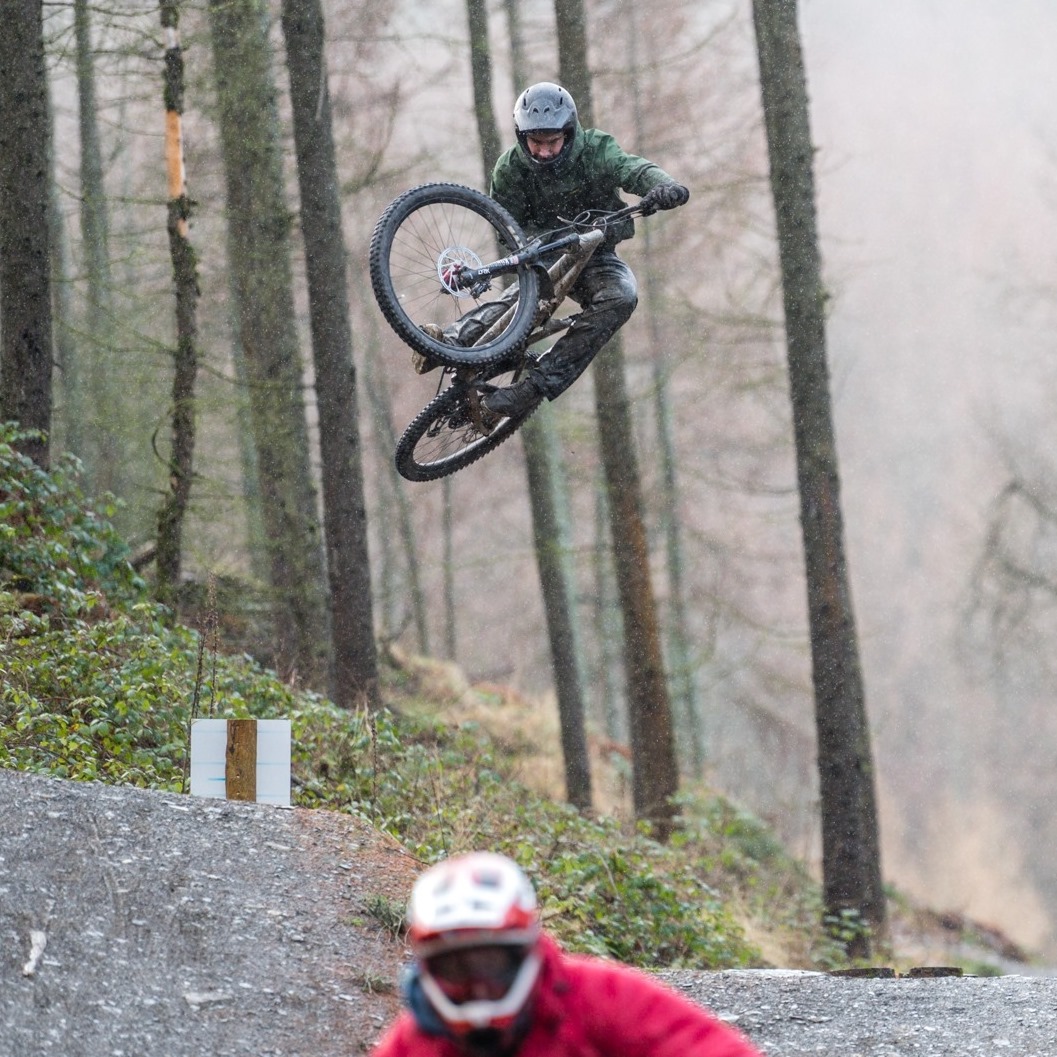What Mountain Bike Frame Size Should I Get?
/ Beginners / What Mountain Bike Frame Size Should I Get?
If you’re searching for what mountain bike frame size you should get, then your search is over. This post will assist you in choosing the right frame size of your bike.
Choosing the right bike frame size was not a matter of priority for the riders in the past. But with the growing interest of the riders, they have now realized that there is a lot more to riding than just a good solid bike.
But there’s no consistency, and you might frequently find one brand’s 17-inch to be a medium-size bike, and for others, it is large. It is especially cased with 17-inch and 19-inch bike frames.
Neither it is consistent from one bike to another, nor does it tally with the sizing charts that the brands have. Therefore, you can conclude that shopping for the right bike frame size is not that simple. And it is truly applicable when you are shopping online and can’t try before you buy.
Important Points To Consider Before We Get Going
Before answering what mountain bike frame size should I use, you must know the principle of choosing the right frame size applies to both men and women. Women have the same principal proportions of bodies as men have.
There is no such thing as longer legs and a shorter torso. Bikes are for humans, end of the debate. Keeping this in mind, all the following advice is for men and women both.
Apart from that, here are some important terms you need to keep in mind. Understanding these terms will help you get the measurements without any issues.
- Seat tube length: Distance from the midpoint of the bottom bracket to the seat tube’s top.
- Effective top tube length: Virtual horizontal line in the middle of the top of the head tube to the seat post’s center
- Stack height: Distance between the top head tube’s center and the bottom bracket center.
- Down tube length: Distance between the bottom bracket center and the bottom head tube center.
- Front center: Length (horizontal) between front axle center and the bottom bracket center.
- Bottom bracket height: Distance between the floor and the bottom bracket center.
So What Size Mountain Bike Do I Need?
Getting on the way of addressing what mountain bike frame size should I use! Often is the case when bikes are measured by the length of their seat tubes. But it is a serious problem to tackle. Anyone starting out asks what size mountain bike do I need?
The length of the seat tube is very important, but it is not that important for the bike frame’s measurement. In the modern era, bike manufacturers use Large, Medium, and Small instead of 19-inch, 17-inch, and 15-inch. And it is a better idea to provide the customers with the bike frame size. So what measurements become more important than its reach and standover!
Reach And Its Importance
It is the distance from a bike’s bottom bracket axle to the top of (center of) your bike’s head tube.
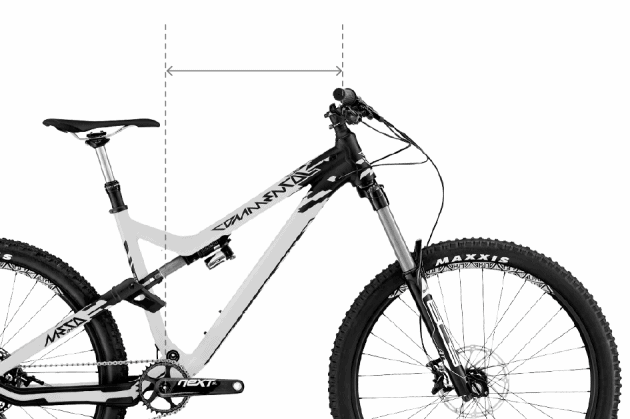
It is a very tough measurement to take in practical unless you don’t have any issue taking measuring tapes and plumb lines to your shop. A good quality measurement tape would make your measuring life a lot easier. But if you look at any good quality bike brand, they will have the reach measurements for their bikes mentioned in the charts too.
So why is it vital in the matter of what mountain bike frame size you should use? Well, it determines who comfortably the bike fits to you. Adjusting your saddle height up and down would only accommodate the length of your seat tube, but reach is something that you cannot adjust. If the reach is too small, then the bike frame size will always be small for you.
And if you are thinking that you can make adjustments to the reach measurement by altering the height of the stem or sliding the saddle back on its rails. Altering the stem will also cause changes in how the bike would steer and its handling.
Slid back saddles won’t be anything when you are standing up on our side of it. Even when you are sitting on a slid-back saddle, you will be getting inefficient pedal power and a front end of your bike that is prone to lifting.
The Standover!
Standover is an easier version of the sizing of the seat tube. It is the height of the top tube. When you stand on the ground right in front of your saddle with just 70mm in the front bottom bracket!
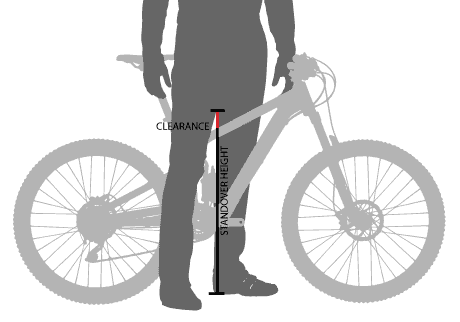
It’s a tricky measurement to take in person, but it should be there in the bike’s geometry chart. You need to measure the inside of your leg because it will tell you whether the bike you are considering has enough standover or not. If your inside leg is 28-inch, then don’t go for a 30-inch standover, otherwise it will hurt your groin.
Mountain Bike Sizing
You might be expecting to have a look at a chart that is simple to read and features rider height against the recommended frame size. Well, that’s not the case. Every bike brand comes with frame size and rider height chart and all-mountain bike mag websites, but it still isn’t going to work.
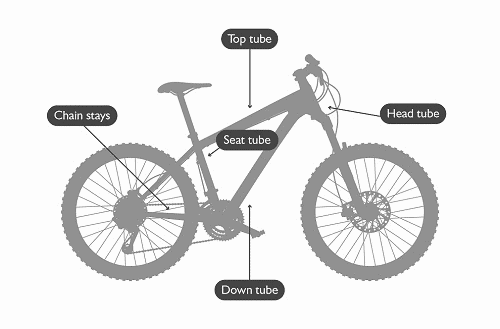
However, we do recommend the right reach according to the rider’s height. It will address a significant portion of your question: what mountain bike frame size should I use!
| Rider height | Reach |
| 5’ 2” – 5’ 6” | 410mm – 450mm |
| 5’ 6” – 5’ 10” | 430mm – 470mm |
| 5’ 10” – 6’ 2” | 450mm – 490mm |
| 6’ 2” – 6’ 6” | 470mm – 510mm |
The people who are used to conventional advice might have gotten startled here. And the progressively minded folks would think that we are conservative here. But generally speaking, we are recommending getting larger frame sizes that can manage an affordable standover. Therefore, if you have always ridden a large bike, then you will end up going for the XL or even an XXL. It’s just the way it is, and frame sizing has always been incorrect.
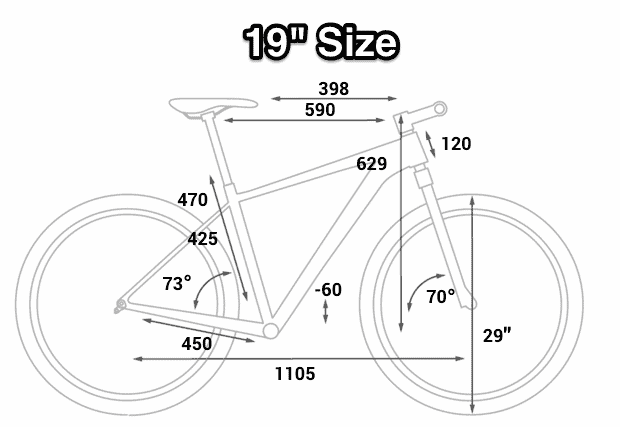
Dropper Fit
But there is a word of caution as well. When you are upsizing the bike frame size, make sure to check that you will fit in the dropper post with enough drop travel to it. Bikes that even feature a huge standover can still have very lengthy seat tubes at times when you have a limit on going up in the frame size. You might have some difficulty fitting in a travel dropper with 150mm and your saddle ends up being too high as well.
Stem Length
The entirely new way of finding whether the bike frame size fits you or not heavily relies on the stem. The stems longer than 60mm shouldn’t be on a mountain bike, period. Anyone who says that they prefer a long stem isn’t riding the right frame size, and it’s too small.
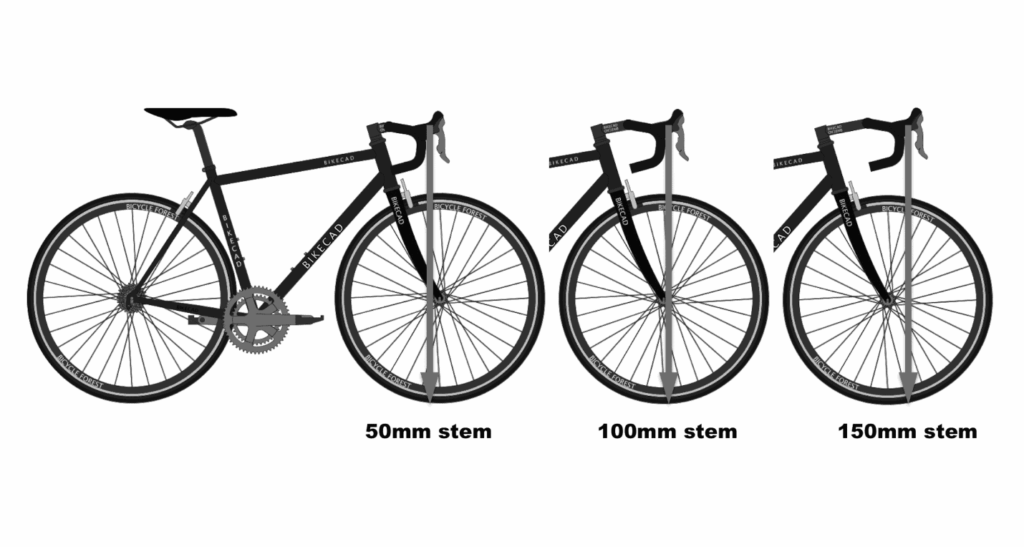
A longer stem is merely sticking plaster because it is far better to go for a bike that has long-enough reach. Ideally, mountain bikes should only come with stems range in size from 30mm to 50mm.
However, most of them still come with 60mm or even longer stems. Stem length is critical in the matter of what mountain bike frame size should I use!
Saddle Height
Saddle height is very important because it tells you how your bike feels when you sit on it. You need to set the saddle height and make the right adjustments. If you can’t get the saddle to the right size, then the bike is not the recommended size for you. You can also go for a comfortable mountain bike saddle with excellent cushioning.
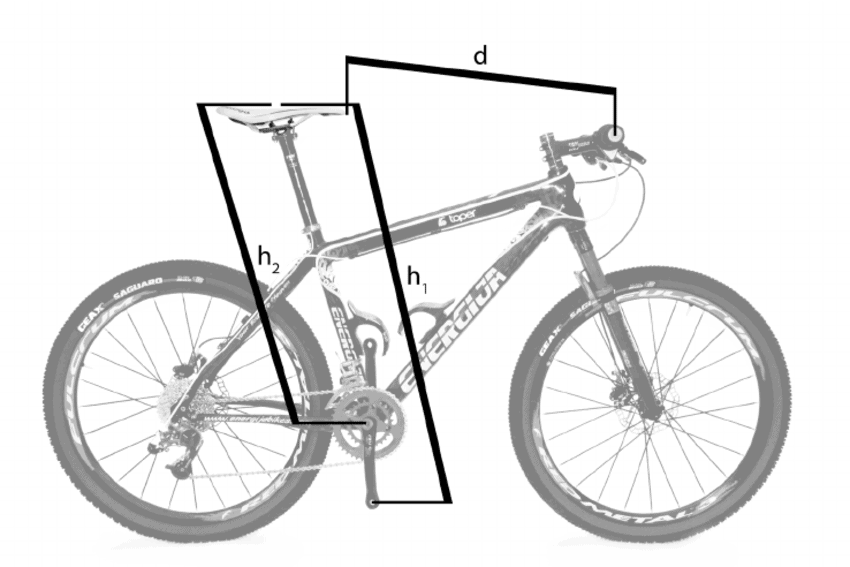
The max seat height ideal for efficient paddling is a rough approximation of your trouser leg measurement along with an additional 5 inches from pedal’s center top to the saddle’s center top. For more accuracy, sit on your saddle squarely with its cranks in a straight down/up position.
The saddle will be at the right height when your heel is touching the top of the lower pedal with a straight leg, and the crank should be right at the stroke’s bottom. If you need to tilt to one side to get to this position and then the saddle is too high. It also depends on what type of shoes you are wearing. You get the general idea of what we’re talking about here.
The saddle position also has a role to play here. For most riders, the ideally suitable position is the leveled flat for most riders. But some riders might prefer to go for a saddle that is slightly tipped back for downhill work or stunts. Saddle height is equally important in the issue of what mountain bike frame size should I use!
Handlebar Height
The height of your handlebar is the function of your bike’s stack height along with the steerer tube lengths. Of course, stem height rise and the handlebar rise are there as well if you bike features these. Some riders prefer a relaxed ride with their handlebars roughly around the height of their saddles. Others prefer them to be a lot lower than their saddle height for that flat back posture while riding the bike.
Don’t Choose The Wrong Size
If you go with the sizing advice of a bike brand or magazine, then you will end up with a bike that is too short with its reach. For instance, a 6’ tall person will have a large bike with a 75mm stem, which is not right.
The ideal size, in this case, is Extra Large with a 45mm stem. Therefore, don’t be hesitant to try a frame next size up and swap the stem with a shorter one. A good quality bike shop can do that for you.
Issues of a Bike With the Wrong Size
Your bike needs to have all its components angled in the right manner. It is important because, with a good bike position, you will have relaxed shoulders as well as slightly bent elbows. If you don’t go for the right bike frame size or if it is too small, you might suffer from,
- With too cramped a position, you might injure yourself from longer rides.
- Potential issues associated with toe overlap were your feet clip with the front wheel.
- Excessive standover clearance might lead to back issues when sitting for longer rides.
If your bike is a bit too big for you, then you might suffer from,
- Sore back due to overreaching during long rides.
- No standover clearance might result in wince-inducing ride experiences.
- Less control over your bike.
Your ride needs to be comfortable for you in all aspects. And your bike frame has a lot to do with it. Therefore, go through the bike geometry before finalizing your purchase decision.
We are not saying the traditional sizing chart is wrong and don’t consult it. We are just saying that don’t take it as a word from the gospel. Just consider it as a reference.
Conclusion
You need to go for the right bike frame size to ensure comfortable riding. The conventional sizing advice available to everyone is not the correct one because it might tell you to ride a bike that is too small for you. Therefore, deciding merely on the frame size and rider height sizing chart is not going to be a useful technique.
Choosing the correct bike frame size is a lot more complicated task than that. You need to take various important measurements before choosing the right size according to your height. Reach and standover are the two of the most important ones, and then there are the handlebar, stem, and saddle adjustments as well.
The rule of the thumb here is to go for a mountain bike frame that is a size up and has a shorter stem. For example, if you are 6 feet tall and you ideally choose a large bike with a 75mm stem, then choose an Extra Large model with a 45mm stem.
Ride on!
Related Articles
What Are Mountain Bike Rock Gardens?
Oli L • September 5, 2022
So you're getting into mountain biking and not sure what mountain bike rock gardens are. Riding rock gardens on a mountain bike is a skill to learn when you first start riding. You might have thought that most trails will be smooth and easy to navigate through but remember that each trail is different. Preparing for these obstacles will help you become a better mountain biker. Rock gardens can come...
The Full Suspension Vs. Hardtail Debate Continues
Oli L • August 28, 2022
The full suspension vs. hardtail debate continues as we look at the pros and cons of each type of bike. Both full suspension and hardtail mountain bikes are great options if you want to start mountain biking. But what do you really need to know about each type before buying one? Mountain biking has exploded in popularity in recent years. The sport involves riding through singletracks mostly in beautiful mother...
6 Mountain Bike Maintenance Tips For Beginners
Oli L • August 8, 2022
There are many different types of mountain bikes out there. But, they all have one thing in common – ongoing maintenance. Mountain bike maintenance can be tricky if you don’t know what you’re doing, you could end up damaging your bike or even yourself. Mountain bikes require proper maintenance to keep everything running smoothly. In this article, we'll show you what to do when things go wrong as a beginner...
8 Steps To Becoming A Better Mountain Biker
Oli L • June 13, 2022
Mountain biking is an activity that requires skill, strength, endurance, and balance. It’s also a great way to stay fit and enjoy the outdoors. But before you hit the trails, there are a few things you need to know to become a better mountain biker. The activity requires both strength and skill. It’s also a sport that has become increasingly popular in recent years. To improve your riding skills, you...
5 Mountain Bike Racing Tips for Beginners
Oli L • June 10, 2022
Mountain bikes are becoming increasingly popular in recent years. They offer an exciting way to explore the outdoors. It also offers many physical and mental health benefits on top of the friendly competition that many enjoy. We're going to go over 5 mountain bike racing tips for beginners to help you get going. MTB racing is an exciting sport that combines speed, agility, and strength in a way that few...
Latest Articles
Popular Articles
Product Of The Week
Monday 26th May
